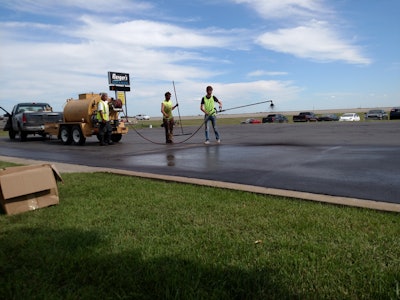
In 2011 Ron LaCoe got the idea to try using recycled crushed glass to replace silica sand and boiler slag in sealcoating jobs. He and son Cody, co-owners of A-1 Sealcoating & Asphalt Maintenance, West Fargo, ND, did some investigating and on-the-job testing, and in 2013 brought the product to National Pavement Expo where it received quite a bit of attention – but few sales.
But that didn’t dissuade them.
Since then they’ve used it successfully on more sealcoating jobs than LaCoe can count, have generated excitement from the Environmental Protection Agency, used it on U.S. Air Force properties, and are in discussion with North Dakota DOT to use it on the shoulders of all the state highways.
“We were talking with someone from the DOT and he said ‘you don’t have enough glass to go across the state of North Dakota’ and I said ‘you don’t know how much beer people drink’,” LaCoe says.
Start-up Works the Small Jobs
Thirty years ago, as a disabled vet with no job, LaCoe started doing building maintenance and in 1977 bought a used parking lot sweeper. Soon after he built his own striping machine using an old Craftsman lawn mower, eventually bought a used striper from the city of Bismarck, and he bought a new striper in 1987.
“Basically we were a striping and cleaning company until 1987, but we started adding pavement maintenance because people needed it,” he says.
To add pavement repair to his business he bought a 55-gal. drum and would fill that drum with hot mix at the plant, then drive from site to site to make pavement repairs (he eventually bought a dump truck).
“We focused on the piddly stuff no one else wants – we still do,” he says. “The big asphalt companies want the big jobs and we focus on the little stuff. It works out fine.”
In 2012 Ron and Cody decided to add sealcoating to their services. He and his daughter, Jessie, built their own 550-gal., trailer-mounted sealcoating system complete with agitation. They used it until 2015 when they bought a Seal-Rite trailer-mounted spray rig.
Today the 3-person company generates 75% of its sales from pavement repair and sealcoating work, 15% from crackfilling and 10% from striping. Almost all their work is parking lot work, but they also sealcoat driveways and access roads in the many lake area homes. “Lake area homes are great for work,” he says. “We went into one lake and had one job and before we left we’d finished 14.”
Replacing Sand with Glass
When A-1 began offering sealcoating services they learned that sealer producers recommended adding boiler slag or silica sand to the sealer. They tried boiler slag but didn’t like it, so they switched to silica sand.
“The silica sand really improved the product and made it last longer – and our customers were happy,” LaCoe says.
But LaCoe didn’t like the potential health issues associated with silica sand, especially since they were using so much of it and adding it into the sealer on their own at the jobsite.
That got him thinking; he wanted to provide the enhanced sealcoating product but he didn’t want to expose himself and others to the dangers posed by silica sand and dust. Then he thought about the landfill that he drove by twice on each trip to his supplier and he thought about all the glass bottles he could see in the dump. Lots and lots of bottles. And he wondered how much more space there would be in the landfills if the bottles weren’t there.
Then he called a glass crushing plant.
“We showed them the silica sand and asked if they could provide glass that was the same granule size and clean and they said they can provide clean glass in any size granules we wanted,” LaCoe says.
He left that day with 400 lbs. of ground glass and used it in place of silica sand on a job just to test it out. “It worked out great,” he says. So they upped the ante, placing 750 lbs. of glass on a bank parking lot and then 950 lbs. on a job and then 1,400 lbs. on another job.
“It didn’t take us long to realize we were on to something,” he says. “The glass worked just fine – and it had the added benefits of being healthier for the workers and being great for the environment because we were removing a lot of bottles from landfills.”
LaCoe contacted the EPA, who he says had never heard of or considered using glass this way, and they liked the idea and encouraged him to pursue it.
How Glass Works in the Mix
Ron LaCoe says A-1 uses the ground glass exactly the way they had used silica sand, adding 2-3 lbs. per gallon of sealer. They use an additive on 90% of their jobs to help the glass bond to the sealer, the same as they would for silica sand.
“We buy our sealer without additive or abrasive in it and mix it on site because each job varies and because the condition of the asphalt varies job to job,” Cody says. “We’ll use up to about 4 lbs. per gallon and then bump up the additive to help the particles in the sealer stay bonded to the glass.”
Cody says that when comparing glass particles to sand grains under a microscope the sand contains pores while the glass does not. “Sand looks like a sponge and can absorb the water from the sealer. Glass has no pores so it doesn’t absorb moisture,” Cody says.
“We control the size of glass particles based on how oxidized the lot is,” he says.
Mix designs generally recommend using sand or boiler slag in the 50 to 70 grade range. A-1 Sealcoating chooses from three different grades of crushed glass depending on the surface being sealed.
- 10-20 grade is used only on the most severely oxidized and aged pavement. It’s considered “coarse to very coarse” and is added at the jobsite by the contractor.
- 15-35 grade is less coarse and is used on pavement that is not new but also not severely oxidized or damaged. Also added at the jobsite.
- Minus-80 grade filler is an almost powder-like material that can be added by the sealer producer at the plant or by the contractor at the jobsite. Minus 80 crushed glass is used on new or like-new pavement.
A-1 used to buy its crushed glass in 55-gal. drums but it’s become such a mainstay of their operation that they now buy it in 3,000-lb. totes. LaCoe says the cost of crushed glass comparable to silica sand.
Cody says they apply sealer using squeegee or spray depending on what the customer wants, and the glass in sealer goes down no differently than sand or boiler slag. He says the glass has created no issues with the spray sealcoating system. In fact he says he thinks silica sand might wear out a spray system quicker.
“I haven’t tracked it or tried to measure it but my feeling is we changed tips more frequently when we used only silica sand,” he says.
LaCoe says the choice of aggregate is up to the customer. He says when the job specs require it they do use a pre-mixed sealer that contains silica sand. But if silica sand or pre-mixed sealer isn’t specified for a job they try to use crushed glass.
LaCoe says they have offered incentives to customers to encourage them to use glass. When bidding the Border Town Bar & Grill’s parking lot, for example, A-1 Sealcoating offered the bar a $400 discount if the bar saved its beer and liquor bottles for a month and gave them to A-1. “We picked them up and trucked them to the glass company and they crushed them and we put that glass right back in the bar’s parking lot,” LaCoe says.
“You can use crushed silica sand which has health and environmental issues, but since you have an option why not go a healthier route and use glass?” he says.


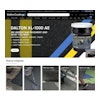


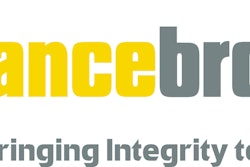





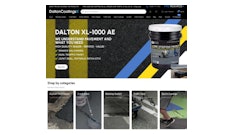
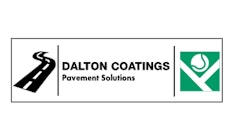
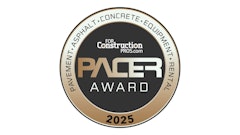


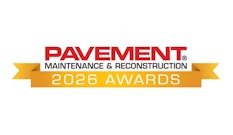
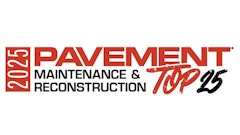
![Pavement Awards 2025[main]](https://img.forconstructionpros.com/files/base/acbm/fcp/image/2024/05/PavementAwards_2025_main_.665883e4276e8.png?ar=16%3A9&auto=format%2Ccompress&bg=fff&fill-color=fff&fit=fill&h=135&pad=5&q=70&w=240)


